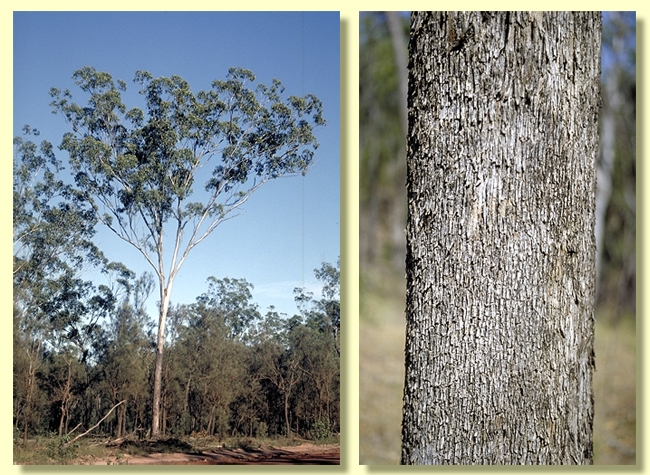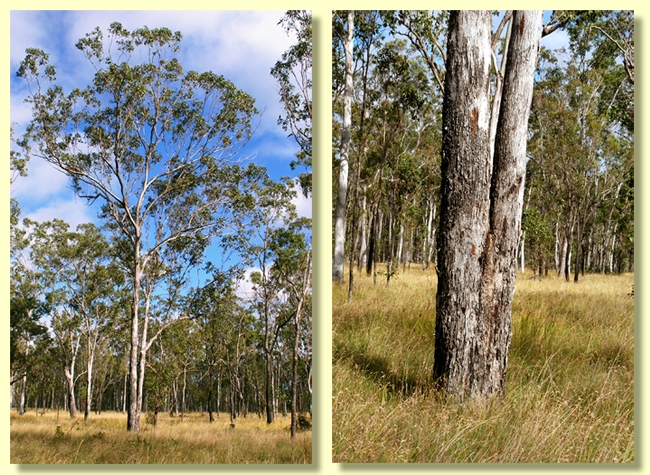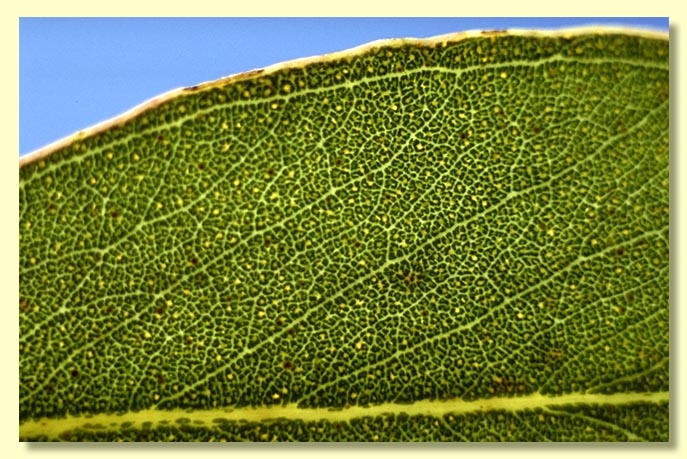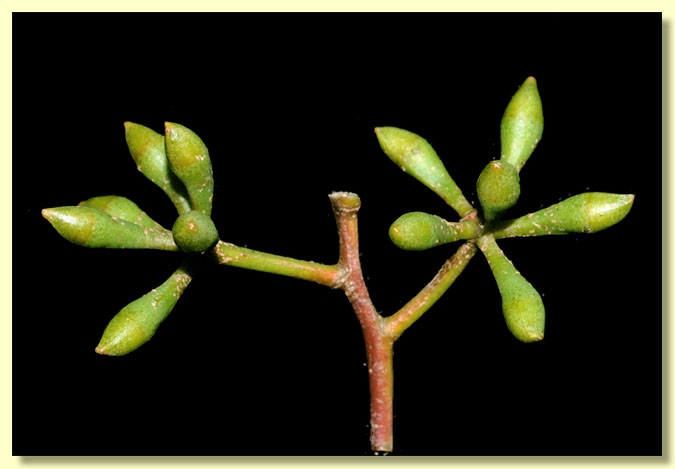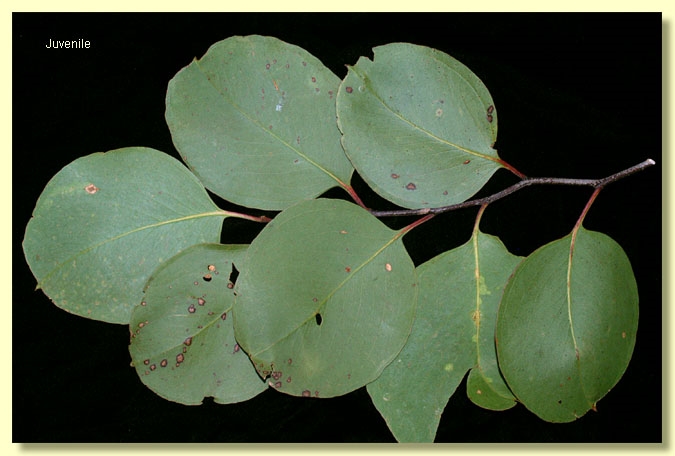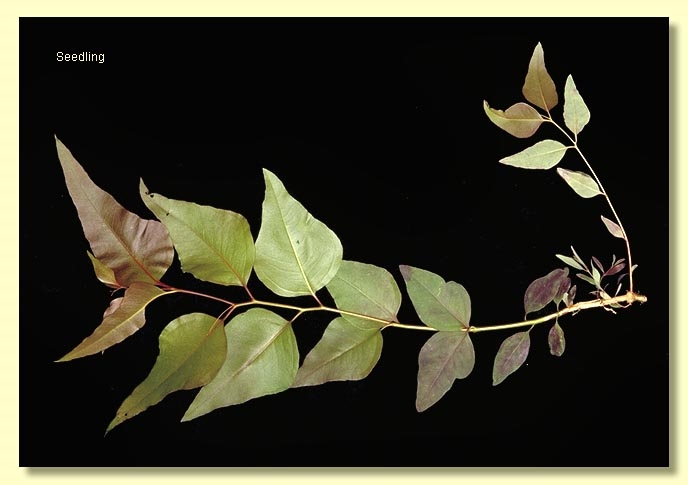Euclid - Online edition
Eucalyptus moluccana
Eucalyptus | Symphyomyrtus | Adnataria | Apicales | Buxeales | Continentes
T: cultivated in Amboyna, Indonesia, C.Smith s.n.; ?holo or iso: BM, fide L.A.S.Johnson, Contr. New South Wales Natl Herb. 3: 115–116 (1962).
Eucalyptus hemiphloia F.Muell. ex Benth., Fl. Austral. 3: 216 (1867). T: Moreton Bay, Qld, F.Mueller s.n.; syn: MEL ; Parramatta, NSW, W.Woolls s.n.; syn: MEL.
Bark rough on part or all of trunk, thin, box-type or tessellated, grey or mottled with grey and white patches; smooth bark white, cream or pale-grey, often shiny; pith of branchlets sometimes glandular.
Juvenile growth (coppice or field seedlings to 50 cm): stem rounded in cross-section; juvenile leaves always petiolate, opposite for 3 to 7 nodes then alternate, ovate, 4–8 cm long, 2.5–5.5 cm wide, discolorous, green.
Adult leaves alternate, petiole 1–2.5 cm long, blade broadly lanceolate to lanceolate, 7–17 cm long, 1.5–6.5 cm wide, base tapering to petiole, concolorous, glossy, green, side-veins at an acute or wider angle to midrib, densely to very densely reticulate, intramarginal vein parallel to and remote from margin, oil glands mostly intersectional.
Inflorescence terminal compound, sometimes axillary compound, peduncles 0.6–1.3 cm long, buds 7 per umbel or sometimes more than 7, pedicels 0.2–0.5 cm long. Mature buds fusiform to diamond-shaped, 0.4–0.8 cm long, 0.2–0.4 cm wide, scar absent, operculum conical, stamens irregularly flexed, anthers adnate, cuboid or globoid, dehiscing by broad lateral or subterminal pores, style long, stigma blunt or tapered, locules 3 or 4, the placentae each with 4 vertical ovule rows. Flowers white.
Fruit sessile or on pedicels to 0.5(0.7) cm long, cup-shaped to barrel-shaped, (0.3)0.4–0.7 cm long, 0.3–0.6 cm wide, disc descending, valves 3 or 4, enclosed.
Seeds brown to grey, 1–2 mm long, flattened-ovoid, dorsal surface pitted, hilum ventral.
Cultivated seedlings (measured at ca node 10): cotyledons reniform to oblong; stems square in cross-section; leaves petiolate, opposite for 3 to 6 pairs then alternate, ovate to orbicular or oblong, 4–9 cm long, 3–7 cm wide, base truncate to rounded, margin entire, apex pointed, dull, green.
Flowering has been recorded in January, February, March, April, May, June, August, October, November and December.
A medium-sized to tall box tree widespread on coastal plains and lower slopes of ranges, north through eastern New South Wales from Nowra and Bungonia to the western side of the Northern Tablelands e.g. Inverell, extending through south-eastern and central Queensland as far north as the Atherton Tableland. In Queensland it occurs as far inland as Texas, Barakula, Consuelo Tableland, Bogantungan, Torrens Creek and Mount Garnet. Soils tend to be heavy alluvial in valleys but not exclusively so as it also is found on basalt and even limestone on slopes. Eucalyptus moluccana is characterised by the rough grey bark on the trunk and smooth white branches, glossy green crown and terminal inflorescences. It is closely related to E. microcarpa, a more inland species with rough bark higher up the stem and smaller leaves, buds and fruit. Fruits of E. moluccana are barrel-shaped and resemble those of the related New South Wales tableland and western slopes species, E. albens. The latter species differs, however, in having a greyish to glaucous crown and larger, often glaucous, buds and fruit.
In the classification of Brooker (2000) Eucalyptus moluccana belongs in Eucalyptus subgenus Symphyomyrtus section Adnataria (the boxes) because the buds have two opercula, ovules are in four rows, seeds are flattened-ovoid, cotyledons are reniform, and anthers are rigid on the staminal filaments. Within section Adnataria, E. moluccana is part of a subgroup, series Buxeales subseries Continentes, further distinguished by having buds that retain the outer operculum until flowering time when both opercula are shed together. Most species in this group are from eastern Australia and have all stamens fertile and are woodland trees of hills and plains, often dominant in the landscape, viz. E. albens, E. molucanna, E. microcarpa and E. woollsiana. Others, viz. E. viridis, E. polybractea, E. froggattii, E. odorata, E. albopurpurea and E. porosa, are mallees, some of them also occurring as small trees occasionally.
The closely related species E. moluccana, E. microcarpa and E. woollsiana differ mainly in the size of the juvenile leaves, other dimensions being overlapping to various degrees:
Fruit
l x w cm
Adult leaves
l x w cm
Juvenile leaves
l x w cm
Juvenile leaves
l:w ratio range
woollsiana
0.2-0.4 x 0.2-0.4
7.5-13.5 x 0.6-1.5
6-15 x 0.3-1.5
(6)10-20
microcarpa
0.3-0.9 x 0.3-0.5
6-15 x 1-3
6-15 x 3-5.5
2-3
moluccana
0.3-0.7 x 0.3-0.6
7-17 x 1.5-6.5
4-8 x 2.5-5.5
1.5-2
Based on specimens at CANB
Extra Note: A population of mallees with buds, fruit and adult and juvenile leaves indistinguishable from E. moluccana occurs on the south-western Darling Downs region of Queensland, in Yelarbon State Forest. The habitat is unusual for this taxon being flat with lateritic sandy clay loam with ironstone gravel and the mallees are associated with Triodia vella and Allocasuarina luehmanii (fide M.D. Crisp 11696, held at CANB).

